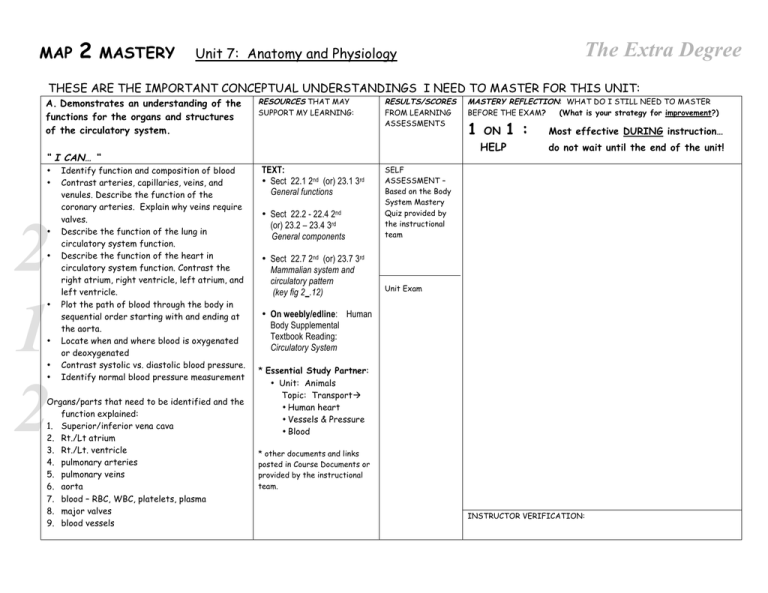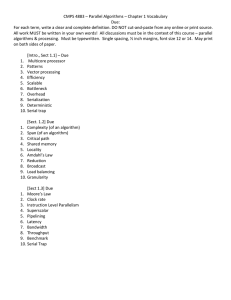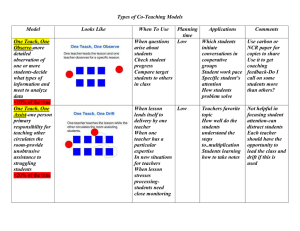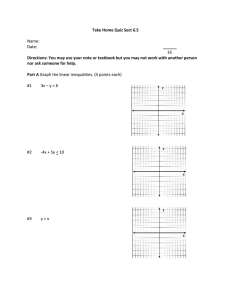The Extra Degree 2 MAP MASTERY
advertisement

MAP 2 MASTERY The Extra Degree Unit 7: Anatomy and Physiology THESE ARE THE IMPORTANT CONCEPTUAL UNDERSTANDINGS I NEED TO MASTER FOR THIS UNIT: A. Demonstrates an understanding of the functions for the organs and structures of the circulatory system. RESOURCES THAT MAY SUPPORT MY LEARNING: RESULTS/SCORES FROM LEARNING ASSESSMENTS 2 1 2 • • • • • • Identify function and composition of blood Contrast arteries, capillaries, veins, and venules. Describe the function of the coronary arteries. Explain why veins require valves. Describe the function of the lung in circulatory system function. Describe the function of the heart in circulatory system function. Contrast the right atrium, right ventricle, left atrium, and left ventricle. Plot the path of blood through the body in sequential order starting with and ending at the aorta. Locate when and where blood is oxygenated or deoxygenated Contrast systolic vs. diastolic blood pressure. Identify normal blood pressure measurement Organs/parts that need to be identified and the function explained: 1. Superior/inferior vena cava 2. Rt./Lt atrium 3. Rt./Lt. ventricle 4. pulmonary arteries 5. pulmonary veins 6. aorta 7. blood – RBC, WBC, platelets, plasma 8. major valves 9. blood vessels 1 ON 1 : HELP “ I CAN… “ • • MASTERY REFLECTION: WHAT DO I STILL NEED TO MASTER BEFORE THE EXAM? (What is your strategy for improvement?) TEXT: • Sect 22.1 2nd (or) 23.1 3rd General functions • Sect 22.2 - 22.4 2nd (or) 23.2 – 23.4 3rd General components SELF ASSESSMENT – Based on the Body System Mastery Quiz provided by the instructional team • Sect 22.7 2nd (or) 23.7 3rd Mammalian system and circulatory pattern (key fig 2_.12) Unit Exam Most effective DURING instruction… do not wait until the end of the unit! • On weebly/edline: Human Body Supplemental Textbook Reading: Circulatory System * Essential Study Partner: • Unit: Animals Topic: Transport • Human heart • Vessels & Pressure • Blood * other documents and links posted in Course Documents or provided by the instructional team. INSTRUCTOR VERIFICATION: B. Demonstrates an understanding of the functions for the organs and structures of the digestive system. RESOURCES THAT MAY SUPPORT MY LEARNING: RESULTS/SCORES FROM LEARNING ASSESSMENTS TEXT: * Contras processes of digestion vs. absorption. • Sect 23.3 2nd (or) 24.3 3rd * Contrast mechanical and chemical digestion & Evolution of dig. systems provide examples of each. * Contrast the function of amylases,nproteases, • Sect 22.2 - 22.4 2nd and lipases. (or) 23.2 – 23.4 3rd * Describe the events which occur in the mouth Vert. Systems (key fig 2_.6) which aid in both digestion and absorption. * Identify function of the esophagus and describe • Sect 23.5 - 23.7 2nd Peristalsis (or) 24.5 – 24.7 3rd * Identify what is digested in stomach Struct. & func. of organs * Describe chime? (key figs: 2_.6, 2_.14) * Explain how HCl, pepsin, and mucous aid in Dig. nd rd processes within stomach. Identify ulcer & cause • Sect 23.9 2 (or) 24.9 3 Accessory organ struc. & * Identify what is dig./ Abs. in small intestine func. * ID roles of Bile and bicarbonate in dig process (key figs: 2_.17, 2_.18) * Describe the structure/function of villi. * Identify what is dig./ Abs. in largl intestine • On weebly/edline: Human * explain benefits to dig process that bacteria and Body Supplemental fiber provide Textbook Reading: * Contrast relative lengths of small/large intestine Digestive System * Identify causes of malfunctions such as diarrhea What or constipation * Essential Study Partner: * Identify any roles of pancreas, liver, and • Unit: Animals gallbladder play in digestion and absorption? Topic: Digestion • All sections Organs/parts that need to be identified and the * other documents and links function explained: 2 1 2 esophagus epiglottis salivary glands stomach liver gallbladder 1 ON 1 : HELP “ I CAN… “ * * * * * * MASTERY REFLECTION: WHAT DO I STILL NEED TO MASTER BEFORE THE EXAM? (What is your strategy for improvement?) * pancreas * small intestine * large intestine * appendix * rectum * enzymes responsible for digestion Most effective DURING instruction… do not wait until the end of the unit! SELF ASSESSMENT – Based on the Body System Mastery Quiz provided by the instructional team Unit Exam posted in Course Documents or provided by the instructional team. INSTRUCTOR VERIFICATION: The Extra Degree C. Demonstrates an understanding of the functions for the organs and structures of the respiratory system. RESOURCES THAT MAY SUPPORT MY LEARNING: RESULTS/SCORES FROM LEARNING ASSESSMENTS MASTERY REFLECTION: WHAT DO I STILL NEED TO MASTER BEFORE THE EXAM? (What is your strategy for improvement?) 1 ON 1 : HELP Most effective DURING instruction… do not wait until the end of the unit! “ I CAN… “ • • • • • 2 1 2 Identify the function of the resp. system? Explain gas exchange in the lungs Describe transportation of oxygen/CO2 Describe the mechanism of breathing. Identify the role of the diaphragm and describe its movement related to inhalation/exhalation? TEXT: • Sect 22.12 2nd (or) 23.12 3rd Vert. Resp. (key fig 2_.19) • Sect 22.13 2nd (or) 23.13 3rd Mammalian System • Sect 22.14 2nd (or) 23.14 3rd Gas Exchange Process (key fig 2_.25) Organs/parts that need to be identified and the function explained: nasal cavity bronchus pharynx bronchiole larynx alveoli trachea diaphragm lung * Essential Study Partner: • Unit: Animals Topic: Respiration • All sections D. Demonstrates an understanding of the functions for the organs and structures of the excretory (urinary) system. RESOURCES THAT MAY SUPPORT MY LEARNING: SELF ASSESSMENT – Based on the Body System Mastery Quiz provided by the instructional team Unit Exam * other documents and links posted in Course Documents or provided by instructional team. INSTRUCTOR VERIFICATION RESULTS/SCORES FROM LEARNING ASSESSMENTS Organs/parts that need to be identified and the function explained 1. kidney 2. nephron (as a whole) 3. bowman’s capsule 4. glomerulus 5. renal artery 6. loop of henle 7. ureter 1 ON 1 : HELP “ I CAN… “ • Identify role of the kidneys in maintaining homeostasis • Describe the structure of the kidney • Describe the structure and function of a nephron? • Explain the process of filtration. • Explain reabsorption and secretion (formation of urine) • Explain how urine is eliminated from the body MASTERY REFLECTION: WHAT DO I STILL NEED TO MASTER BEFORE THE EXAM? (What is your strategy for improvement?) TEXT: • Sect 23.10 2nd (or) 24.10 3rd Homeostasis – Nitrogenous wastes. • Sect 23.13 2nd (or) 24.13 3rd Mammalian Kidney Struct. & Funct. (key fig 2_.29) * Essential Study Partner: • Unit: Animals Topic: Osmoregulation All sections • * other documents and links posted in Course Documents or provided by the instructional team. Most effective DURING instruction… do not wait until the end of the unit! SELF ASSESSMENT – Based on the Body System Mastery Quiz provided by the instructional team Unit Exam INSTRUCTOR VERIFICATION: The Extra Degree The Extra Degree E. Demonstrates an understanding of the functions for the structures of the brain and general nervous system. RESOURCES THAT MAY SUPPORT MY LEARNING: RESULTS/SCORES FROM LEARNING ASSESSMENTS MASTERY REFLECTION: WHAT DO I STILL NEED TO MASTER BEFORE THE EXAM? (What is your strategy for improvement?) 1 ON 1 : HELP Most effective DURING instruction… do not wait until the end of the unit! “ I CAN… “ • Describe the function of a neuron as well as its structures: dendrites, axon, and synaptic terminal structures of the neuron. • Describe the function of neurotransmitters • Contrast the functions of the pons, midbrain, medulla, thalamus, and the hypothalamus. • Contrast the functions of the cerebellum and the cerebrum. • Contrast the functions of the frontal, parietal, occipital, and temporal lobes of the cerebrum. • Identify the function of the corpus callosum • Identify the ventricle and its purpose • Identify the function of the spinal cord? • Contrast the roles of the sympathetic and parasympathetic nervous systems. • Contrast the roles of the peripheral and the central nervous systems. TEXT: • Sect 25.2- 4,25.7- 10 2nd ed or) 26.2- 4, 26.7- 10 3rd ed (key figs: 2_.5, 2_.8, 2_.15, 2_.16,, 2_..22,) * Essential Study Partner: • Unit: Animals Topic: Nervous • All sections * other documents and links posted in Course Documents or provided by the instructional team. SELF ASSESSMENT – Based on the Body System Mastery Quiz provided by the instructional team Unit Exam INSTRUCTOR VERIFICATION 2. SCIENTIFIC SKILLS & APPLICATION OF RESEARCH A. B. Demonstrates the ability to identify and describe the structure and function of anatomical structures of a representative mammalian specimen – the pig. Demonstrates knowledge and practice of safe, respectful dissection techniques. Possible METHODS OF ASSESSMENT “ I CAN… “ A. 2 1 2 IDENTIFY STRUCTURES AND FUNCTIONS OF VITAL ORGANS IN MAMMALS VIA DISSECTION OF THE FETAL PIG: *clearly demonstrate an ability to dissect, locate, and identify the following structures or regions of the fetal pig: -small intestine -rib cage -large intestine -bladder -stomach -kidneys -esophagus -spleen -liver -diaphragm -pancreas -lungs -gallbladder -trachea -The heart -Left Ventricle -Coronary Arteries -Left Atrium -Aorta -Right Ventricle -Vena Cava -Right Atrium -Pulmonary Artery - abdominal cavity - thoracic cavity Observation of dissection techniques Fetal Pig Dissection Assessment/Lab practical Unit Exam - Anterior/posterior - dorsal/ventral * treat my specimen with RESPECT and operate an efficient, safe, and clean lab station on a daily basis during this unit. * return all dissection tools CLEAN, dry, and ready for use by the next class period (table is DRY and your sink is CLEAR of solid materials.) The Extra Degree



